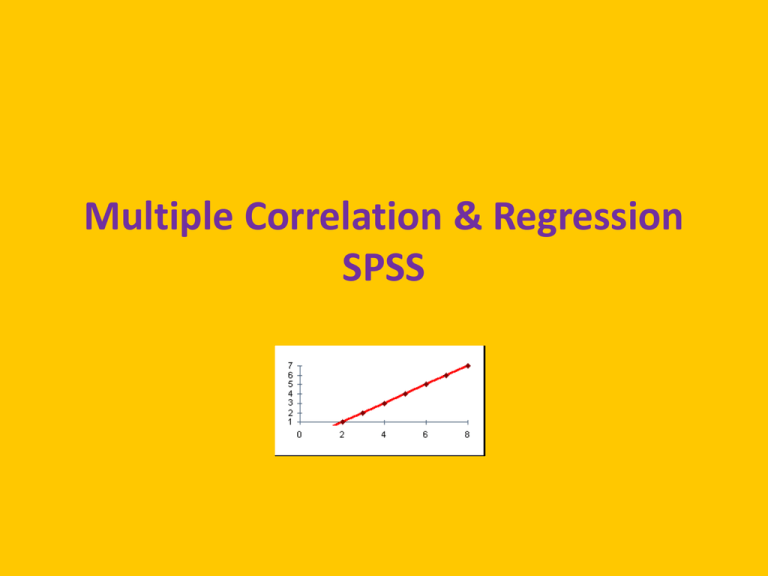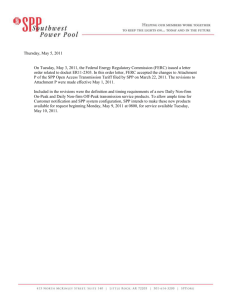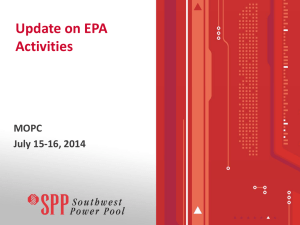Multiple Correlation & Regression with SPSS
advertisement

Multiple Correlation & Regression SPSS Analyze, Regression, Linear Notice that we have added “ideal” to the model we tested earlier. Statistics, Part and Partial Correlations Plots: Zresid Zpredict, Histogram ANOVA F (2, 151) 4.468, p .013 R2 In our previous model, without idealism, r2 = .049. Adding idealism has increased r2 by .056 - .049 = .007, not much of a change. Intercept and Slopes Aˆ r 1.637 .185 Misanth .086 Ideal zˆAr .233 zMisanth .086 zIdeal Aˆ r 1.637 .185 Misanth .086 Ideal • When Misanth and Ideal are both zero, predicted Ar is 1.637. • Holding Ideal constant, predicted Ar increases by .185 point for each one point increase in Misanth. • Holding Misanth constant, predicted Ar increases by .086 for each one point increase in Ideal. zˆAr .233 zMisanth .086 zIdeal • Holding Ideal constant, predicted Ar increases by .233 standard deviations for each one standard deviation increase in Misanth. • Holding Misanth constant, predicted Ar increases by .086 standard deviation for each one standard deviation increase in Ideal. Tests of Partial (Unique) Effects •Removing misanthropy from the model would significantly reduce the R2. •Removing idealism from the model would not significantly reduce the R2. sri2 • The squared semipartial correlation coefficient is the amount of variance in Y that is explained by Xi, above and beyond the variance that has already been explained by other predictors in the model. • In other words, it is the amount by which R2 would drop if Xi were removed from the model. a+b+c+d=1 a + b = r2 for Ar_Mis c + b = r2 for A_Ideal R2 =a+b+c b = redundancy between Mis and Ideal with respect to predicting Ar a = sr2 for Mis – the unique contribution of Mis c = sr2 for Ideal – the unique contribution of Ideal “Part” is the square root of sr2 The sr2 for Misanth is .232 = .0529 The sr2 for Ideal is .0852 = .007 We previously calculated the sr2 for Ideal as the reduction in R2 when we removed it from the model. pr2 • The squared partial correlation coefficient is the proportional reduction in error variance caused by adding a new predictor to the current model. • Of the variance in Y that is not already explained by the other predictors, what proportion is explained by Xi? sr2 versus pr2 • sr2 is the proportion of all of Y that is explained uniquely by Xi. • pr2 is the proportion of that part of Y not already explained by the other predictors that is explained by Xi. pr2 for Mis is a/(a+d); sr2 is a/(a+b+c+d) = sr2/1. pr2 for Ideal is c/(c+d); sr2 is c/(a+b+c+d) = sr2/1. pr2 will be larger than sr2. The pr2 for Misanth is .2312 = .053. The pr2 for Ideal is .0872 = .008. The Marginal Distribution of the Residuals (error) We have assumed that this is normal. Standardized Residuals Plot Standardized Residuals Plot • As you scan from left to right, is the variance in the columns of dots constant? • Are the normally distributed? Put a CI on R2 • If you want the CI to be consistent with the test of significance of R2, use a confidence coefficient of 1-2, not 1-. The CI extends from .007 to .121. Effect of Misanth Moderated by Ideal • I had predicted that the relationship between Ar and Misanth would be greater among nonidealists than among idealists. • Let us see if that is true. • Although I am going to dichotomize Idealism here, that is generally not good practice. • There is a better way, covered in advanced stats classes. Split File by Idealism Predict Ar from Misanth by Ideal For the NonIdealists Ar = 1.626 + .30 Misanth Among Idealists Ar = 2.405 + .015 Misanth Confidence Intervals for • http://faculty.vassar.edu/lowry/rho.html • For the NonIdealists, CI for the Idealists











